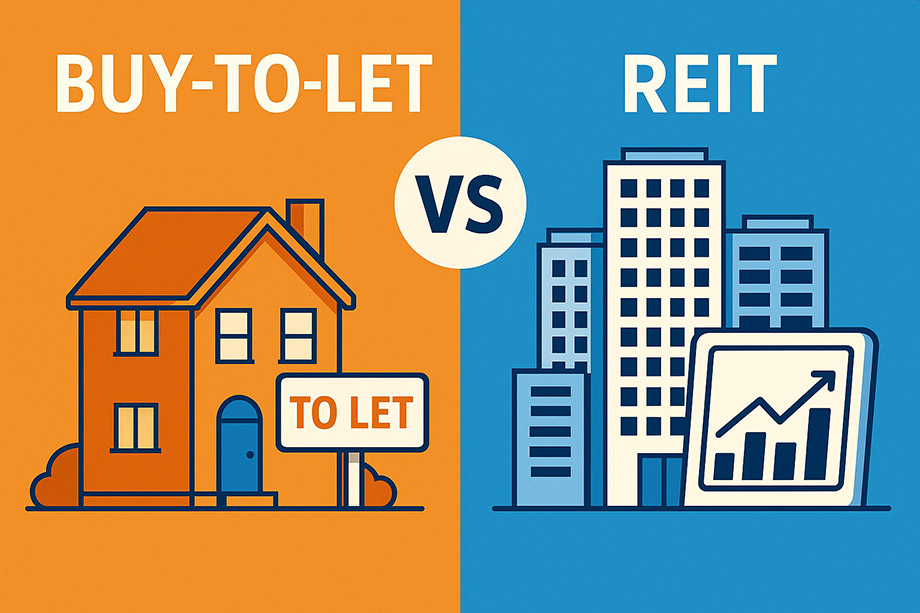Buy-to-Let vs. REIT Investing in the UK: Complete 2025 Comparison Guide

Buy-to-let offers higher potential returns (averaging 8.2% historically) and full control but requires £30,000-£60,000 to start and active management. REITs provide 4-5% average returns with diversification and liquidity for as little as £50, but offer less control and lower returns. With recent tax changes hitting buy-to-let harder, REITs are becoming increasingly attractive for property exposure.
Property investment has long been a cornerstone of UK wealth building, but choosing between direct buy-to-let ownership and Real Estate Investment Trusts (REITs) can significantly impact your returns and experience. This comprehensive guide compares both strategies, helping you decide which approach suits your goals, budget, and risk tolerance in 2025.
What is Buy-to-Let Property Investment?
A buy to let property is a residential apartment or house that you buy with the intention of renting to tenants in exchange for monthly rental payments. Once you begin earning an income from property, you become a landlord, one of more than 2.66 million in the UK.
How Buy-to-Let Works
The Process:
- Purchase Property: Buy a residential property with the intention of renting it out
- Find Tenants: Market and let the property to suitable tenants
- Collect Rent: Receive monthly rental payments (typically yielding 3-6% annually)
- Property Management: Handle maintenance, repairs, and tenant relationships
- Capital Growth: Benefit from property value appreciation over time
Typical Investment Requirements:
- Deposit: Usually 25% of property value (minimum £20,000-£60,000)
- Mortgage: Buy-to-let mortgage for remaining 75%
- Additional Costs: Legal fees, surveys, stamp duty, refurbishment
- Ongoing Expenses: Maintenance, insurance, management, void periods
Types of Buy-to-Let Investment
Standard Residential Lets:
- Single-family homes or flats
- Typical yields: 3-6% gross
- Target market: Young professionals, families
Houses in Multiple Occupation (HMOs):
- Multiple tenants sharing facilities
- Higher yields: 6-12% potential
- More complex regulation and management
Student Accommodation:
- Purpose-built or converted properties near universities
- Yields: 5-8% typical
- Seasonal rental patterns
What are REITs (Real Estate Investment Trusts)?
REIT is an acronym which stands for Real Estate Investment Trust. It is a company that makes investments in income-generating properties and then passes its earnings on to owners.
How REITs Work
REITs are companies that own, operate, or finance income-generating real estate. Like other publicly-traded companies, investors can buy shares in REITs, giving them access to a share of the rental income. Because REITs bundle all properties into a single corporation, the value of these shares can be pennies a piece, making them accessible to virtually anyone.
REIT Structure:
- Property Portfolio: REITs own multiple properties across various sectors
- Professional Management: Experienced teams handle property operations
- Income Distribution: Must pay out at least 90% of rental profits as dividends
- Public Trading: Shares traded on stock exchanges like any other company
Types of UK REITs
By Property Sector:
- Residential REITs: Rental apartments and housing developments
- Commercial REITs: Office buildings, retail centers, warehouses
- Industrial REITs: Distribution centers, manufacturing facilities
- Healthcare REITs: Hospitals, care homes, medical facilities
- Mixed-Use REITs: Diversified property portfolios
Popular UK REITs Examples:
- British Land Company PLC
- Land Securities Group PLC
- Segro PLC (industrial/logistics)
- Big Yellow Group PLC (self-storage)
- Primary Health Properties PLC (healthcare)
Head-to-Head Comparison: Buy-to-Let vs. REITs
Investment Amount and Accessibility
Buy-to-Let:
- Minimum Investment: £30,000-£60,000 for first-time investors
- Total Property Value: Typically £100,000-£400,000+
- Leverage Available: Up to 75% loan-to-value mortgages
- Barriers to Entry: High capital requirements, mortgage approval needed
REITs:
- Minimum Investment: As little as £50-£100
- Maximum Flexibility: Invest any amount you choose
- No Leverage: Cannot use borrowed money to amplify investment
- Easy Access: Buy through any stockbroker or investment platform
Expected Returns and Performance
Buy-to-Let Historical Performance:
- Rental Yields: 3.6% average gross yield
- Capital Growth: 4.6% annual house price appreciation
- Total Returns: Averaged around 8.2% since 2010
- Regional Variation: Wide performance differences by location
REIT Historical Performance:
- Dividend Yields: 4-5% typical annual returns
- Capital Growth: Variable, market-dependent
- Total Returns: 7.2% average annual total return (2010-2020) according to Savills
- Consistency: More stable year-on-year performance
Risk and Diversification
Buy-to-Let Risk Profile:
- Concentration Risk: Single property exposure
- Tenant Risk: Income depends on 1-2 tenants
- Location Risk: Tied to specific area’s performance
- Market Risk: Local property market fluctuations
- Liquidity Risk: Can take months to sell property
REIT Risk Profile:
- Diversification: Spread across multiple properties and locations
- Professional Management: Reduced operational risk
- Market Correlation: Still subject to property market cycles
- Liquidity Advantage: Can sell shares immediately during market hours
- Stock Market Volatility: Share prices can fluctuate with market sentiment
Management and Time Commitment
Buy-to-Let Management:
- Active Involvement: Tenant finding, maintenance coordination, rent collection
- Time Requirements: 5-20 hours per month depending on issues
- Professional Management Option: Pay 8-15% of rental income for full management
- Legal Responsibilities: Landlord duties, safety regulations, tenant rights
- Problem Resolution: Direct handling of repairs, disputes, void periods
REIT Management:
- Passive Investment: No day-to-day involvement required
- Professional Teams: Experienced property managers handle operations
- Zero Time Commitment: Simply hold shares and receive dividends
- No Legal Obligations: No landlord responsibilities or duties
- Hands-Off Approach: Perfect for busy professionals or retirees
Tax Implications: A Crucial Difference in 2025
Buy-to-Let Tax Treatment (2025)
Income Tax on Rental Income:
- Tax Rates: 20%, 40%, or 45% depending on total income
- Mortgage Interest Relief: Now limited to 20% tax credit (not full deduction)
- Allowable Expenses: Maintenance, repairs, management fees, insurance
- Quarterly Reporting: Making Tax Digital requirements from 2026
Capital Gains Tax:
- CGT Rates: 18% (basic rate) or 24% (higher rate) on residential property
- Annual Allowance: £3,000 CGT allowance (2024/25)
- No Main Residence Relief: Buy-to-let properties don’t qualify
Stamp Duty Land Tax:
- Additional Rate: 5% surcharge on entire purchase price (increased from 3% in 2024)
- Example: £300,000 property = £15,000 additional SDLT
- No Relief: No exemptions for buy-to-let purchases
Recent Tax Changes Impacting Buy-to-Let:
- Furnished Holiday Let reliefs abolished (April 2025)
- Mortgage interest relief restrictions (fully implemented)
- Higher stamp duty rates on additional properties
REIT Tax Treatment
Dividend Tax:
- Dividend Rates: 8.75% (basic), 33.75% (higher), 39.35% (additional rate)
- Dividend Allowance: £500 tax-free dividend allowance (2024/25)
- ISA Advantage: No tax on REIT dividends held in Stocks & Shares ISA
- SIPP Advantage: No tax within Self-Invested Personal Pensions
Capital Gains Tax:
- CGT Rates: 10% (basic rate) or 20% (higher rate) on shares
- Annual Allowance: £3,000 CGT allowance applies
- Lower Rates: Significantly lower than property CGT rates
Stamp Duty:
- Stamp Duty Reserve Tax: 0.5% on UK-listed REIT purchases
- Much Lower Cost: £300,000 REIT investment = £1,500 stamp duty vs. £15,000 for buy-to-let
Tax Efficiency Comparison
| Tax Aspect | Buy-to-Let | REITs |
|---|---|---|
| Income Tax Rate | 20-45% on rental profits | 8.75-39.35% on dividends |
| CGT Rate | 18-24% | 10-20% |
| Stamp Duty | 5% additional rate | 0.5% on shares |
| ISA Eligibility | No | Yes (tax-free) |
| SIPP Eligibility | No | Yes (tax-free) |
Liquidity and Flexibility
Buy-to-Let Liquidity
Selling Timeline:
- Marketing Period: 2-6 months typical
- Legal Process: 6-12 weeks from offer to completion
- Total Time: 4-8 months to convert to cash
- Market Conditions: Can take longer in slow markets
Costs of Exit:
- Estate Agent Fees: 1-3% of sale price
- Legal Fees: £500-£1,500
- Capital Gains Tax: 18-24% on gains
- Total Exit Costs: Often 3-5% of property value
REIT Liquidity
Immediate Trading:
- Market Hours: Buy/sell instantly during trading hours
- Settlement: T+2 settlement (receive cash in 2 days)
- No Marketing: No need to find buyers
- Market Price: Current market value always available
Low Exit Costs:
- Broker Fees: £0-£15 per trade typically
- No Agent Fees: No estate agent involvement
- CGT Only: Capital gains tax only on profits
- Total Exit Costs: Usually under 1% of investment value
Market Conditions and Outlook (2025)
Buy-to-Let Market Challenges
Current Pressures:
- Rising Interest Rates: Higher mortgage costs affecting yields
- Tax Changes: Reduced tax relief making investments less attractive
- Regulatory Burden: Increasing landlord obligations and costs
- Stamp Duty Increases: 5% surcharge making acquisition expensive
Market Statistics:
- Landlord Exodus: 37% increase in landlords selling (December 2024)
- Rental Shortage: Reducing supply pushing up rents
- Yield Compression: Lower net yields after tax and costs
- Regional Variation: Some areas still offering attractive opportunities
REIT Market Outlook
Positive Factors:
- Professional Management: Better positioned to handle regulatory changes
- Diversification Benefits: Spread risk across multiple properties
- Scale Advantages: Lower costs per unit through economies of scale
- Dividend Requirements: Mandatory 90% profit distribution
Market Value:
- UK REIT Market: £58 billion in outstanding shares (March 2023)
- Growing Acceptance: Increasing recognition as property alternative
- Institutional Investment: Strong professional manager involvement
- Dividend Yields: Stable income streams attractive in current environment
Who Should Choose Buy-to-Let?
Ideal Buy-to-Let Investors
Financial Profile:
- Available Capital: £30,000-£60,000+ for deposits and costs
- Stable Income: Ability to service mortgage and cover void periods
- Higher Rate Taxpayers: May benefit from mortgage interest relief
- Long-term Focus: Planning to hold properties for 5+ years
Personal Characteristics:
- Hands-on Approach: Enjoy property management or willing to pay for management
- Local Knowledge: Understanding of specific areas and rental markets
- Risk Tolerance: Comfortable with concentration risk and leverage
- Time Availability: Can dedicate time to landlord responsibilities
Investment Goals:
- Full Control: Want complete decision-making authority
- Higher Returns: Seeking potentially higher returns through leverage
- Portfolio Building: Planning to build substantial property portfolio
- Legacy Planning: Creating tangible assets to pass on
When Buy-to-Let Makes Sense
Market Conditions:
- Attractive Yields: Finding properties with 6%+ gross yields
- Growth Areas: Investing in areas with strong rental demand and capital growth
- Below Market Value: Opportunities to add value through renovation
- Strong Rental Market: Areas with consistent tenant demand
Who Should Choose REITs?
Ideal REIT Investors
Financial Profile:
- Limited Capital: Starting with smaller amounts (£100-£10,000)
- Diversification Seekers: Want property exposure alongside other investments
- ISA Investors: Utilizing Stocks & Shares ISA allowances
- Pension Investors: Building retirement portfolios
Personal Characteristics:
- Passive Approach: Prefer hands-off investing
- Busy Professionals: Limited time for property management
- Risk Averse: Prefer diversified exposure over concentration risk
- Liquidity Priority: Value ability to access money quickly
Investment Goals:
- Income Focus: Seeking regular dividend income
- Diversification: Adding property exposure to existing portfolio
- Professional Management: Prefer expert management of property assets
- Tax Efficiency: Maximizing tax-advantaged account usage
When REITs Make Sense
Market Conditions:
- High Property Prices: When direct property investment is unaffordable
- Complex Regulations: When landlord responsibilities seem burdensome
- Market Volatility: When professional management provides stability
- Income Requirements: When reliable dividends are priority
Advanced Strategies: Combining Both Approaches
Portfolio Diversification Strategy
Many experienced investors use both buy-to-let and REITs as complementary investments:
Core-Satellite Approach:
- Core Holdings: REITs providing stable, diversified property exposure
- Satellite Investments: Select buy-to-let properties in high-opportunity areas
- Risk Balance: Spreading risk across different property investment types
Allocation Examples:
- Conservative: 70% REITs, 30% direct property
- Balanced: 50% REITs, 50% direct property
- Aggressive: 30% REITs, 70% direct property
Geographic and Sector Diversification
REIT Diversification:
- UK residential REITs
- UK commercial REITs
- International REIT exposure
- Sector-specific REITs (healthcare, logistics)
Buy-to-Let Diversification:
- Different geographic regions
- Various property types (flats, houses, HMOs)
- Different tenant markets (professionals, students, families)
Step-by-Step: Getting Started
Starting with REITs
1. Choose Investment Platform:
- Popular Platforms: Hargreaves Lansdown, AJ Bell, Interactive Investor
- Consider Costs: Platform fees, dealing charges, ISA availability
- REIT Selection: Filter by dividend yield, sector, size
2. Select REITs:
- Research Options: Review dividend history, property portfolio, management team
- Diversification: Consider multiple REITs across different sectors
- Start Small: Begin with £500-£1,000 to learn
3. Investment Execution:
- Market vs. Limit Orders: Decide on purchase price strategy
- Regular Investing: Consider monthly investments to smooth timing
- Reinvestment: Plan whether to reinvest dividends or take income
Starting with Buy-to-Let
1. Financial Preparation:
- Deposit Savings: Accumulate 25%+ deposit plus additional costs
- Mortgage Pre-approval: Get agreement in principle for buy-to-let mortgage
- Emergency Fund: Maintain reserves for void periods and maintenance
2. Market Research:
- Location Analysis: Research rental yields, capital growth, tenant demand
- Property Types: Decide on flats vs. houses, new vs. period properties
- Professional Network: Find solicitors, surveyors, accountants, agents
3. Property Acquisition:
- Property Search: Use property portals, agents, auction houses
- Due Diligence: Professional surveys, legal checks, rental assessments
- Purchase Process: Legal completion and immediate rental preparation
Cost Analysis Examples
REIT Investment Example (£50,000)
Initial Costs:
- Investment Amount: £50,000
- Platform Fee: £45 per year (Hargreaves Lansdown)
- Dealing Charges: £11.95 per trade
- Stamp Duty: £250 (0.5%)
- Total Initial Cost: £50,307
Annual Returns (4.5% dividend yield):
- Gross Dividends: £2,250
- Tax (higher rate): £672 (assuming £500 allowance used)
- Net Annual Income: £1,578
- Net Yield: 3.1%
Buy-to-Let Investment Example (£200,000 property)
Initial Costs:
- Property Price: £200,000
- Deposit (25%): £50,000
- Stamp Duty (5% additional): £10,000
- Legal Fees: £1,500
- Survey: £600
- Total Initial Cost: £62,100
Annual Income (5% gross yield):
- Gross Rental Income: £10,000
- Mortgage Interest: £4,500 (3% on £150,000)
- Other Expenses: £2,000 (maintenance, insurance, management)
- Taxable Profit: £3,500
- Tax Relief (20%): £900
- Income Tax (40%): £1,400
- Net Annual Income: £2,100
- Net Yield on Deposit: 4.2%
Risk Management Strategies
Buy-to-Let Risk Mitigation
Tenant Risk:
- Comprehensive Referencing: Credit checks, employment verification, previous landlord references
- Rent Guarantee Insurance: Covers rent arrears and legal costs
- Deposit Protection: Secures deposit in government-approved scheme
Property Risk:
- Comprehensive Insurance: Buildings, contents, landlord liability coverage
- Regular Maintenance: Preventive maintenance to avoid major repairs
- Professional Management: Hiring experienced letting agents
Market Risk:
- Area Diversification: Multiple properties in different locations
- Property Type Mix: Different property types and tenant markets
- Exit Strategy Planning: Regular portfolio reviews and disposal plans
REIT Risk Mitigation
Diversification:
- Multiple REITs: Spread investment across different companies
- Sector Diversification: Mix of residential, commercial, industrial
- Geographic Spread: UK and international exposure
Market Risk:
- Regular Monitoring: Track performance and market conditions
- Gradual Investment: Dollar-cost averaging over time
- Professional Advice: Consider managed REIT funds for broader exposure
Common Mistakes to Avoid
Buy-to-Let Pitfalls
Financial Mistakes:
- Under-budgeting: Not accounting for void periods and major repairs
- Over-leveraging: Taking on too much debt relative to income
- Ignoring Tax Changes: Not factoring in current tax treatment
- Poor Location Choice: Buying in areas with weak rental demand
Management Mistakes:
- DIY Everything: Trying to handle all aspects without professional help
- Tenant Selection Errors: Inadequate referencing leading to problem tenants
- Maintenance Neglect: Deferring maintenance leading to bigger problems
- Legal Non-compliance: Failing to meet landlord legal obligations
REIT Investment Mistakes
Selection Errors:
- Chasing High Yields: Focusing only on dividend yield without considering sustainability
- Lack of Research: Not understanding underlying property portfolio
- Concentration Risk: Investing in only one or two REITs
- Timing Issues: Trying to time the market rather than investing regularly
Tax Mistakes:
- Ignoring Allowances: Not using ISA and dividend allowances effectively
- Poor Account Choice: Holding REITs in taxable accounts unnecessarily
- Dividend Timing: Not considering tax year timing for dividend payments
Future Trends and Considerations
Technology Impact
PropTech Developments:
- Digital Platforms: Online property management tools
- AI and Data Analytics: Better market analysis and pricing
- Virtual Reality: Remote property viewings and management
- Blockchain: Potential for fractional property ownership
Regulatory Evolution
Buy-to-Let Regulation:
- Energy Efficiency Requirements: Minimum EPC ratings
- Tenant Protection: Strengthened tenant rights and protections
- Professional Standards: Potential licensing requirements
- Tax Policy: Continued scrutiny of tax advantages
REIT Developments:
- Market Growth: Expansion of UK REIT market
- Product Innovation: New REIT structures and focuses
- International Access: Easier access to global REIT markets
- ESG Integration: Environmental and social governance focus
Making Your Decision: Key Questions
Self-Assessment Questions
Financial Readiness:
- How much capital do you have available to invest?
- Can you afford 6-12 months of mortgage payments without rental income?
- Are you comfortable with leveraged investments?
- Do you have other income sources to service the investment?
Time and Involvement:
- How much time can you dedicate to property management?
- Do you enjoy hands-on involvement or prefer passive investing?
- Are you prepared for emergency property issues?
- Do you have local knowledge of rental markets?
Risk Tolerance:
- Are you comfortable with concentration risk?
- How important is liquidity to you?
- Can you handle property market volatility?
- Do you need predictable income or can you accept variability?
Investment Goals:
- Are you seeking income, capital growth, or both?
- What is your investment timeline?
- How does property fit into your overall portfolio?
- Are you building wealth or seeking retirement income?
Conclusion: Choosing Your Property Investment Strategy
Both buy-to-let property and REITs offer viable paths to property investment, but they suit different types of investors and circumstances. The choice ultimately depends on your available capital, risk tolerance, time commitment, and investment objectives.
When to Choose Buy-to-Let
Best for investors who:
- Have substantial capital (£30,000-£60,000+) available
- Want full control over their property investments
- Are comfortable with hands-on management or can afford professional management
- Seek potentially higher returns and can handle concentrated risk
- Have good local market knowledge
- Can commit time to landlord responsibilities
- Are comfortable with leverage and illiquid investments
When to Choose REITs
Best for investors who:
- Have limited capital or want to start small
- Prefer passive, hands-off investing
- Value liquidity and want easy access to their money
- Seek diversification across multiple properties
- Want professional property management
- Prefer lower minimum investments and easy scaling
- Value tax efficiency through ISAs and SIPPs
- Want exposure to commercial as well as residential property
The Hybrid Approach
Many successful property investors use both strategies:
- Start with REITs to gain property market exposure while building capital
- Graduate to buy-to-let when sufficient funds and knowledge are accumulated
- Maintain both for diversification and risk management
- Use REITs for liquidity and buy-to-let for control and higher potential returns
Looking Ahead
The property investment landscape continues to evolve, with changing tax policies, new regulations, and technological innovations. REITs are becoming increasingly attractive as buy-to-let faces higher tax burdens and regulatory complexity. However, direct property investment still offers compelling opportunities for those with the capital, time, and expertise to succeed.
Key Takeaway: There’s no universally “right” choice between buy-to-let and REITs. The best strategy depends on your individual circumstances, goals, and preferences. Consider starting with REITs if you’re new to property investing, then potentially expanding into buy-to-let as your experience and capital grow.
Remember: Property investment, whether direct or through REITs, should form part of a diversified investment portfolio. Always consider seeking professional financial advice tailored to your specific situation before making significant investment decisions.
Whether you choose the hands-on approach of buy-to-let, the professional management of REITs, or a combination of both, property investment can play a valuable role in building long-term wealth. The key is choosing the approach that aligns with your circumstances and goals, then executing your strategy consistently over time.
Last Updated on August 3, 2025 by James Cartwright







